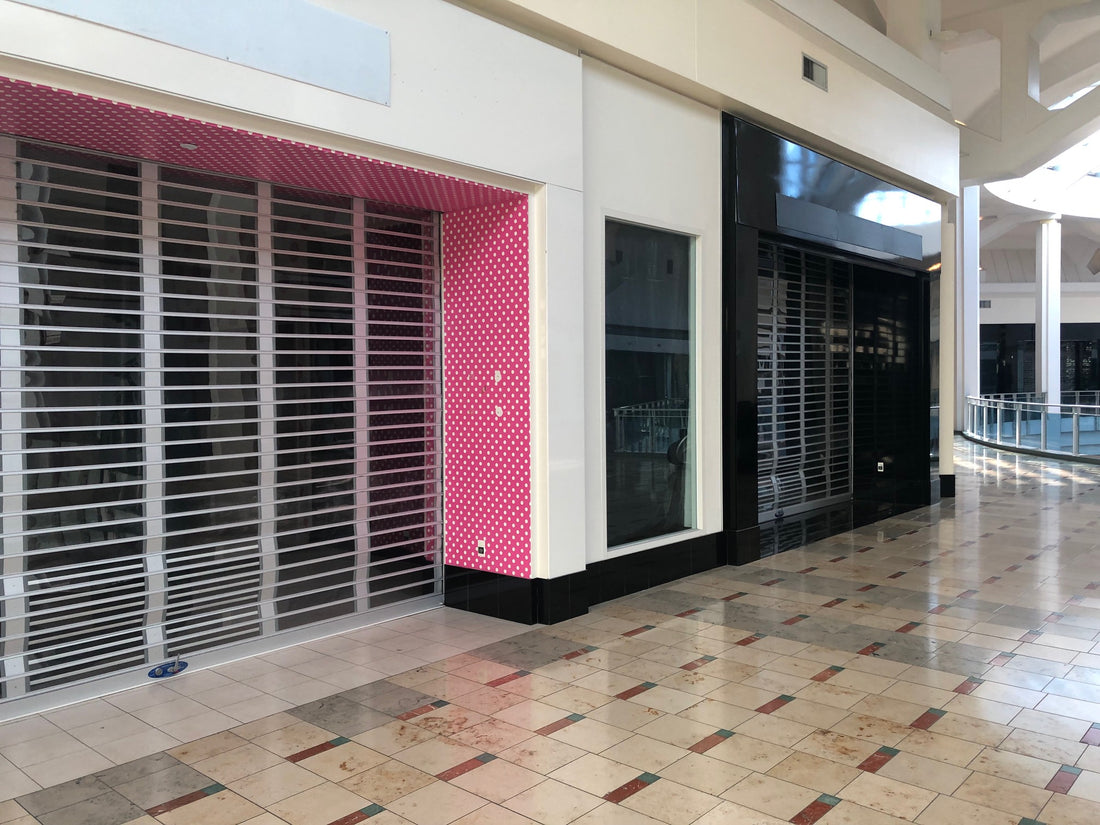For over 60 years, the shopping mall has been loved and reviled in America. And now it seems its time may be coming to an end. These iconic masses of concrete, steel, tile, and carpeting are in a steady state of decline due to several factors. A bad economy, the rise of online shopping, and changing lifestyles are contributing to the demise of the shopping mall. It wasn’t always this way, of course.
Save 20% on any and all shirts from our Dead Malls Collection with the code "ghostmall."
History of the Shopping Mall
The idea of an indoor shopping center goes back to the 1890s and the opening of The Arcade in downtown Cleveland. Nestled between two office buildings, this five-story structure is still in operation today and is filled with various types of merchants and everyone's favorite meeting place; the food court. Another early indoor shopping center, Kansas City’s Country Club Plaza, opened in 1922. It remains a viable destination and features offices and upscale apartments in addition to its many shops.
The Modern Mall
The first modern mall, Southdale Center, was built in Edina, Minnesota, in 1956. “It's the most important mall ever built,” St. Olaf College (no, really) history professor James Farrell told Marketplace Money in a 2006 radio story on the center’s 50th anniversary. "Every mall (built) after …1956 was just a variation on the theme of Southdale.”
The typical design was anchored by two to four department stores, fully enclosed, and climate-controlled. Most offered around 100 shops and eateries in addition to the anchors. Indeed, the “malling of America” had begun, and after Southdale opened, nearly 1,500 malls would be built, mostly in suburbs, across the U.S. and Canada.
The Golden Age
The heyday of the shopping mall came in the 1980s and early 1990s. They were almost characters unto themselves, in films like Valley Girl, Fast Times at Ridgemont High, and Mall Rats. Indeed, many real-life malls sought to attract teens, apparently under the assumption that young people would come in and spend their money recklessly. This may have ultimately been the undoing of some malls, but for a time it seemed to work. The local mall was the place to be. So ubiquitous was the concept that in 1984 mall developer Edward J. DeBartolo Sr. named his short-lived United States Football League team the Pittsburgh Maulers, an apparent play on his line of work. He owned and operated two of the country’s largest malls, Randall Park Mall in suburban Cleveland and Century III Mall in suburban Pittsburgh.
Americana
Love them or loathe them, shopping malls wove themselves into the fabric of American culture. To the post-World War II generations, it was a communal place. Cynics argued, and still do, that malls were bland, ugly cathedrals in which shoppers could mindlessly worship consumerism. However, people flocked to them in droves throughout the 1970s and 1980s, trailing off only slightly toward the end of the century’s final decade.
Overbuilding, Sprawl, and a Changing Landscape
Malls were still going up at a steady pace in the 1990s, a time when some say the concept was being overbuilt. Several malls were erected only a few miles from existing shopping centers. Often they sprang up in anticipation of coming housing developments, office parks, and highways. However, by the end of the decade, subtle changes were afoot in the retail industry. Discount department stores like Walmart, Target, and Kohl’s, typically not found anchoring malls, began to grow. Kohl’s currently operates in a few malls but normally builds new stores as free-standing locations, often as part of a large outdoor strip center. JC Penny, long a traditional mall anchor, has more recently focused on free-standing locations. These appear to be more viable for the storied retailer.
Take it Outside
Another trend that started taking hold at the beginning of the century was the construction of outdoor shopping centers. Many were designed to look like mini-neighborhoods. These started to appear as early as the 1970s. Notable examples include The Continent in Columbus and Uptown Square in New Orleans, both featuring a European theme.
The number of less-stylish strip malls increased in the 1980s and 1990s, sometimes anchored by a Target, Walmart, or large grocery store. Other big-box retailers like Best Buy, Old Navy, and Bed, Bath & Beyond also started to siphon traffic away from malls. At the same time, new technology was emerging, one that would affect several aspects of American life, including how we shopped – the Internet. While book and music stores were particularly hard hit by the Internet, many other retailers, especially mall merchants, really felt the effects of online shopping. Several merged, while others scaled back their number of locations. Some went out of business altogether.
In some cases, malls were torn down to make way for new lifestyle shopping centers or strip malls. This fate befell the Beechmont Mall in Cincinnati and the Crossroads Mall in Boulder, Colorado, to name two.
Recession
Facing multiple challenges, and various kinds of competition, several malls were struggling by the turn of the century. A slowing economy, fueled by the downturn in the real estate market, drove some entirely out of business. Today there are approximately 1,100 malls in the United States, and close to 10% of those are considered dead malls. Less than a half dozen new centers have opened since 2006, as the number of dead properties continues to grow. Many old malls have been razed, replaced by such things as Walmart and Target super centers and open-air shopping venues. Ironically, it was former Target parent the Dayton Company that developed the Southdale Center Mall in 1956.
Changing Consumer Needs
One of the lasting results of the pandemic has been the trend of people leaving jobs but not taking new ones. The lockdown(s) have shown folks that maybe they don’t need as much stuff and therefore don’t need to work if a spouse or partner has a job. Perhaps they can take a less stressful gig that pays less.
Certainly, e-commerce and the Internet have played a role in the demise of shopping malls. However, only 11 percent of consumer spending takes place online.
The Future of Malls
We will likely never again see the mall building boom of the late twentieth century. Tastes have changed, and the concept is no longer seen as unique or special. However, many malls are relatively healthy, given the state of the economy, the continuing challenges from other types of shopping destinations, and the Internet. The latter has not only impacted shopping, but the social media component may be another contributing factor to the decline of malls as community destinations. Eventually, the decline will probably level off, as people will always want to “go out shopping,” and many will want to do it unencumbered by the elements.



